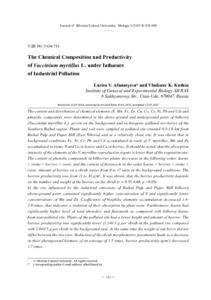Химический состав и продуктивность Vaccinium myrtillus L. в условиях техногенного воздействия
Скачать файл:
URI (для ссылок/цитирований):
https://elib.sfu-kras.ru/handle/2311/19902Автор:
Афанасьева, Л.В.
Кашин, В.К.
Afanasyeva, Larisa V.
Kashin, Vladimir K.
Дата:
2015-09Аннотация:
Определены уровни накопления и особенности распределения химических элементов (S, Mn, Fe,
Zn, Cu, Co, Cr, Ni, Pb, Cd), а также фенольных соединений в растениях черники обыкновенной
(Vaccinium myrtillus L.) на фоновых и загрязненных аэропромвыбросами ОАО «Байкальский
целлюлозно-бумажный комбинат» территориях Южного Прибайкалья. Анализ распределения
элементов по органам черники показал, что в фоновых условиях корни черники отличаются
наиболее высоким содержанием Fe, Ni, Cr, Pb, Cd, стебли – Mn, Zn, листья – S и Co, ягоды – Cu.
Общее содержание фенольных соединений в растениях черники снижается в ряду листья >
стебли > ягоды > корни, флавоноидов – листья > ягоды > стебли > корни. В фоновых условиях
количество ягод на одном парциальном кусте варьирует от 0 до 17 шт., урожайность ягод – от
11 до 34 г/м2. Отмечено, что урожайность ягод в большей степени зависит от их количества
и массы на одном парциальном кусте (r=0.55-0.68, р<0.05) и в меньшей – от количества
плодоносящих кустов (r=0.34-0.45, р<0.05). Высота куста, параметры кроны существенного
влияния на величину урожайности ягод не оказывают.
В зоне атмосферных промышленных выбросов ОАО «БЦБК» в надземных частях черники
при увеличении содержания S в 1.7-1.8 раза наблюдалось снижение концентрации Mn и Zn
в 1.5-2.3 раза и повышение уровня флавоноидов в 1.3-1.5 раза. Коэффициенты накопления
большинства рассмотренных элементов снижались, причем для биофильных элементов в 1.4-
2.0 раза. Обнаружено уменьшение средней высоты парциальных кустов и протяженности
кроны в 1.4 раза, количества ягод и их массы на парциальном кусте в 1.5-1.8 раза по сравнению
с фоновыми значениями, тогда как диаметр кроны и масса одной ягоды практически не
изменялись. Снижение морфометрических параметров парциальных кустов приводит к
уменьшению их надземной фитомассы в среднем в 1.5 раза, а урожайности – в 1.7 раза. The content and distribution of chemical elements (S, Mn, Fe, Zn, Cu, Co, Cr, Ni, Pb and Cd) and
phenolic compounds were determined in the above-ground and underground parts of bilberry
(Vaccinium myrtillus L.), grown on the background and technogenic polluted territories of the
Southern Baikal region. Plants and soil were sampled at polluted site situated 0.5-1.0 km from
Baikal Pulp and Paper Mill (East Siberia) and at a relatively clean site. It was shown that in
background conditions Fe, Ni, Cr, Pb and Cd accumulated in roots of V. myrtillus, Mn and Zn
accumulated in stems, S and Co in leaves and Cu in berries. It should be noted, that the absorption
intensity of the elements of the V. myrtillus reproductive organs is lower than of the vegetative one.
The content of phenolic compounds in bilberries plants decreases in the following order: leaves
> stems > berries > roots, and the content of flavonoids in the order leaves > berries > stems >
roots. Amount of berries on a shrub varies from 0 to 17 units in the background conditions. The
berries productivity was from 11 to 34 g/m2. It was shown, that the berries productivity depends
on the number and weight of the berries on the shrub (r = 0.55-0.68, p <0.05).
In the site influenced by the industrial emissions of Baikal Pulp and Paper Mill bilberry
above-ground parts contained significantly higher concentration of S and significantly lower
concentrations of Mn and Zn. Coefficients of biophilic elements accumulation decreased 1.4-
2.0 times, that indicates a violation of their absorption by plant roots. Furthermore, leaves had
significantly higher level of total phenolics and flavonoids as compared with bilberry leaves
from non-polluted site. Plants of the polluted site had a lower height and amount of berries. The
berries productivity was significantly lower (1.1±0.3 g per shrub in the polluted site compared
with 2.0±0.5 g per shrub in the background one). At the same time the weight of one berry did not
differ between the two sites. Reduction of the shrub morphometric parameters leads to a decrease
in their aboveground biomass of an average of 1.5 times, berries productivity (g/m2) decreased
1.7 times

